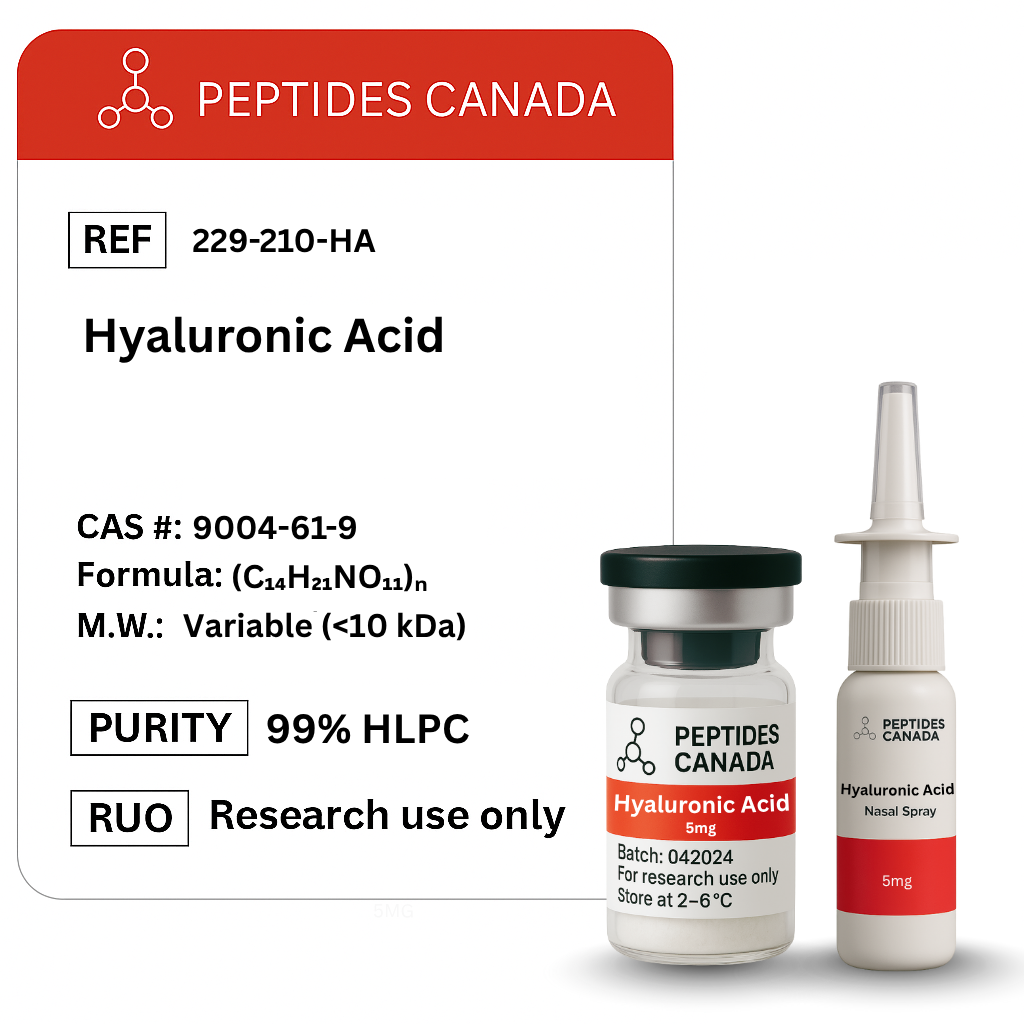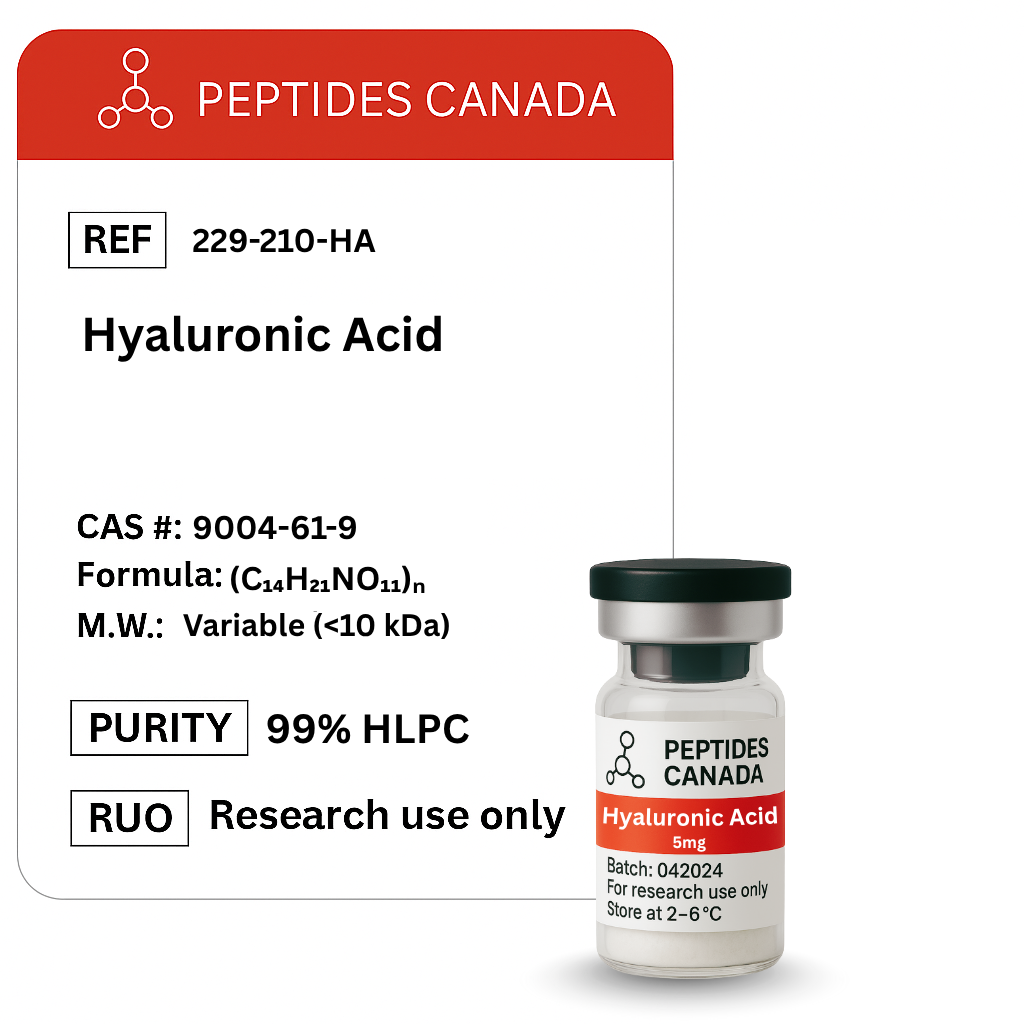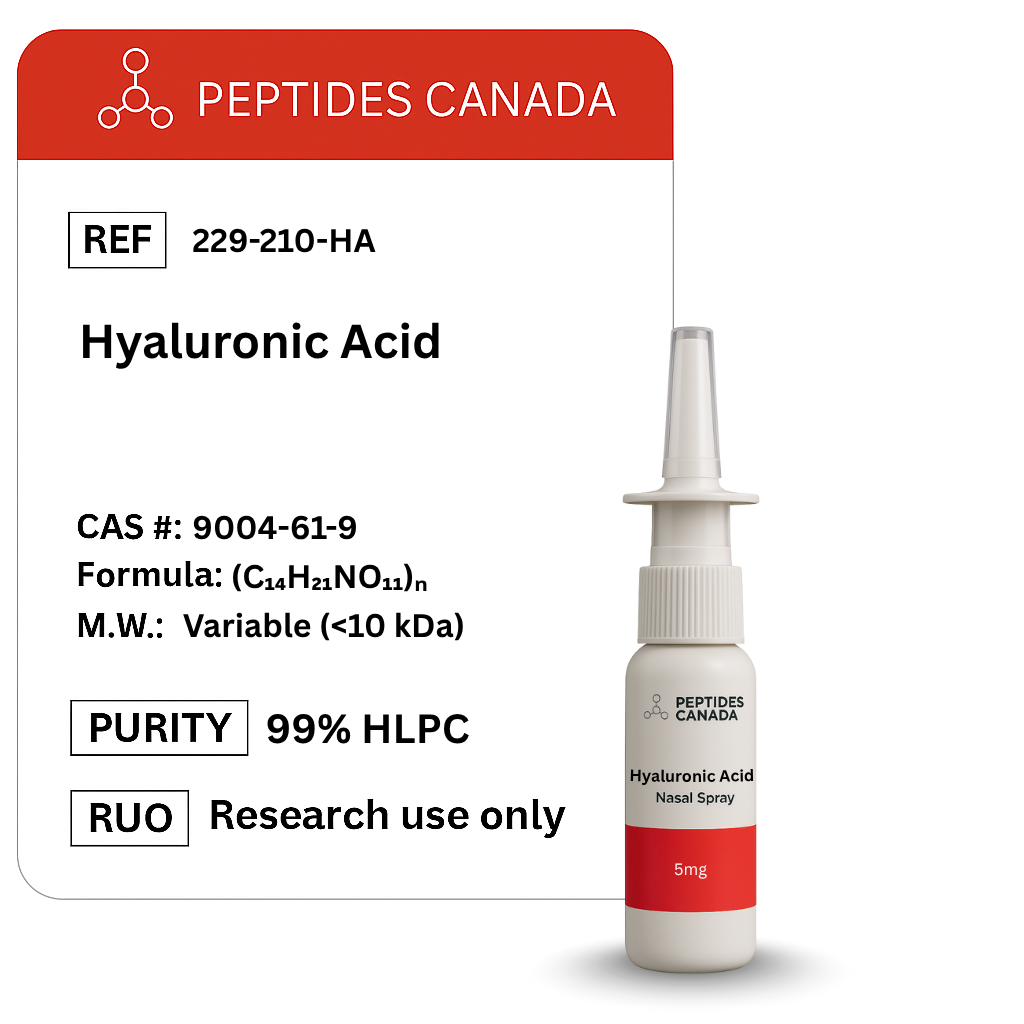Hyaluronic
From CAD $25 CAD $28
Contents: Hyaluronic Acid (Sodium Hyaluronate, Glycosaminoglycan Polymer)
Form: Powder
Purity: 99.3%
TESTED FOR:
- PURITY
- STERILITY
- WEIGHT
- ENDOTOXINS(LPS)
Free Reconstitution solution automatically added to your cart with each order of vial.
This product is Made, Tested & Shipped From Canada.
Ships Today
Order by 1:00 PM EST
Free Shipping
For 2 or more vials
99%+ Purity Guaranteed
COA Verified+
Trackable Shipping
Hyaluronic Acid
Hyaluronic acid (HA) is a high-molecular-weight polysaccharide found throughout connective, epithelial, and neural tissues. It is investigated for its capacity to retain water, support extracellular matrix integrity, and influence cellular communication processes. Research explores HA’s ability to interact with receptors associated with tissue hydration, structural stability, and repair mechanisms.
HA has been evaluated in models of dermal structure, joint biomechanics, and ocular physiology, where it may contribute to lubrication, viscoelastic support, and biomechanical resilience. Investigators also examine its role in inflammatory responses and tissue remodeling under controlled experimental conditions.
Overview
Hyaluronic acid is widely studied for its physicochemical behavior, including viscosity, hydration capacity, and matrix stabilization. Research examines how HA contributes to cellular microenvironments, nutrient diffusion, and proteoglycan organization. Additional investigations explore its influence on wound response biology, oxidative balance, and regenerative dynamics within connective tissues.
Chemical Makeup
Hyaluronic acid is a linear glycosaminoglycan composed of repeating disaccharide units (N-acetyl-D-glucosamine and D-glucuronic acid). Molecular weight can vary across preparations; therefore, a single definitive molecular formula is not listed. Analytical characterization for this batch is confirmed via mass spectrometry and HPLC.
- Observed Mass (MS): 711.9 Da
- Purity (HPLC): 99.42%
- Batch Number: 2025007
- Primary Retention Time: 3.48 min
- Instrument: LCMS-7800 Series (Calibrated)
- Analytical Note: Primary peak confirmed by mass and retention time; trace secondary peak 0.58% area
Research and Clinical Studies
Hyaluronic Acid and Tissue Hydration
HA has been analyzed for its ability to bind substantial water content, helping maintain tissue turgor and biomechanical flexibility in experimental dermal and connective tissue models.
Hyaluronic Acid and Joint Function
Laboratory evaluations assess HA’s viscoelastic behavior in synovial environments, examining its role in joint lubrication and load distribution during movement.
Hyaluronic Acid and Wound Biology
Studies investigate how HA contributes to controlled inflammatory responses, cellular migration, and matrix organization in model systems of tissue repair.
Hyaluronic Acid and Cellular Signaling
Interactions with HA-binding receptors (including CD44) are considered relevant to cell motility, proliferation, and local structural remodeling processes.
Hyaluronic Acid and Oxidative Balance
Experimental data suggest HA may help buffer oxidative stress in environments subject to metabolic or mechanical challenge.
Hyaluronic acid research material is intended exclusively for scientific study by qualified laboratory personnel. Not for human or veterinary administration.
References
- Fraser JR, Laurent TC, Laurent UB. Hyaluronan: its nature, distribution, functions and turnover. J Intern Med. 1997;242(1):27-33. PMID: 9260563.
https://pubmed.ncbi.nlm.nih.gov/9260563/
- Cowman MK, Lee HG, Schwertfeger KL, et al. The functional roles of hyaluronan in health and disease. Carbohydr Res. 2015;404:1-19. PMID: 25620201.
https://pubmed.ncbi.nlm.nih.gov/25620201/
- Litwiniuk M, et al. Hyaluronic acid in wound healing. Wounds. 2016;28(3):78-88. PMID: 26978867.
https://pubmed.ncbi.nlm.nih.gov/26978867/
- Altman RD, et al. Hyaluronic acid in osteoarthritis research. Osteoarthritis Cartilage. 2015;23(11):2103-2111. PMID: 26412638.
https://pubmed.ncbi.nlm.nih.gov/26412638/
- Necas J, et al. Hyaluronic acid in tissue hydration and healing. Vet Med. 2008;53(8):397-411.
https://pubmed.ncbi.nlm.nih.gov/19114355/
- Salwowska NM, et al. Biological properties of hyaluronic acid. Dermatol Rev. 2016;103(1):1-12. PMID: 27378383.
https://pubmed.ncbi.nlm.nih.gov/27378383/
- ClinicalTrials.gov Identifier: NCT04619611. Hyaluronic acid in connective tissue modeling studies.
https://clinicaltrials.gov/ct2/show/NCT04619611
- ClinicalTrials.gov Identifier: NCT05191339. Experimental HA evaluation in dermal biomechanical research.
https://clinicaltrials.gov/ct2/show/NCT05191339
For Research Use Only. Not for human or veterinary use.
HIGHEST QUALITY PEPTIDES
Our products are scientifically formulated and manufactured in cGMP-compliant facilities.
FAST DELIVERY
Enjoy fast and reliable 3–5 day shipping.
Dedicated Customer Service
Our customer service team is highly knowledgeable in peptide research and its applications. We’re available 24/7 to assist you.
Tested. Verified. Trusted.
We take a laboratory-first approach to quality. Each batch is made under controlled conditions and verified by an independent lab (HPLC/MS). We only ship batches that test ≥99% purity, and we provide a full COA, including identity, methods, and chromatograms, for your review.
See the Process for Yourself
We make our peptides in our own cGMP lab. Watch the video to see how every vial is produced, tested, and handled with care.
Science Behind Our Peptides
A clear explanation of how our peptides work, their benefits, why quality matters for best results, and what you should know.
Categories
Categories
How do I know the peptides I order are exactly what the label says?
Every vial we sell comes from a lab that follows current Good Manufacturing Practices (cGMP). That means each step of production is documented and controlled. Before a batch is released, it’s tested by independent third-party labs for purity, identity, and sterility. Certificates of analysis are available so you can see the exact test results.
Are your peptides produced in a sterile and controlled environment?
Yes. The labs we work with use ISO-certified clean rooms where air quality, equipment, and handling procedures are tightly regulated. Staff are trained to pharmaceutical-grade standards. This ensures the peptides are produced in an environment that minimizes contamination risks.
What about shipping? Do the peptides remain stable in transit?
Peptides in lyophilized (freeze-dried) form are stable at room temperature for transport. Once you receive them, refrigeration is recommended to maintain long-term integrity. We package every order securely to prevent damage and ship promptly, so your vials arrive in optimal condition.
How do I know you actually make these peptides yourselves?
We operate under strict in-house protocols that follow current Good Manufacturing Practices (cGMP). That means our team oversees the entire process from sourcing raw amino acids to the final lyophilized vial. Nothing is outsourced or repackaged. This gives us full control over purity, consistency, and sterility, and it’s why we can stand behind every single vial we ship.
What should I do with the vials once they arrive?
Store them in the refrigerator, away from direct light and heat. If you need to keep them longer, some peptides can be stored frozen. Each vial comes with clear handling instructions so you know the proper conditions for stability.
What proof do you have that your peptides are legitimate?
The strongest proof is transparency. For every peptide, we can provide certificates of analysis, manufacturing documentation, and references to the published scientific research behind it. If you ever have questions, we’ll show you the data rather than ask you to take our word for it.






